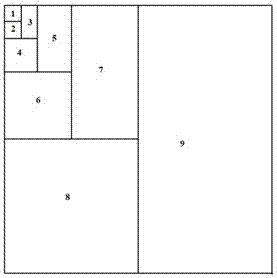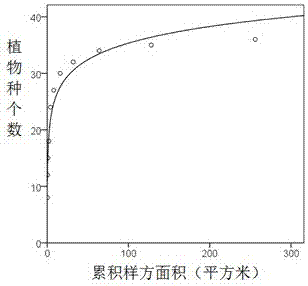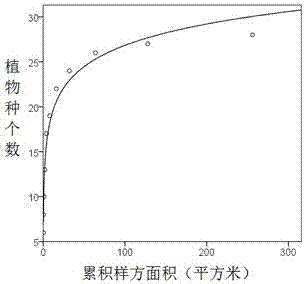Method for calculating sample plot minimum area of Karst mountain vegetation
A karst and area technology, applied in the field of plant ecology, can solve problems such as inconsistent habitat conditions, increased survey costs, and large area, and achieve the effects of avoiding large errors, good repeatability, and accurate calculations
- Summary
- Abstract
- Description
- Claims
- Application Information
AI Technical Summary
Problems solved by technology
Method used
Image
Examples
Embodiment 1
[0044] In November 2015, in the survey of karst mountainous vegetation in Pingzhai Village, Leye, it was first necessary to determine the minimum area of the standard land. In the contiguous 1000m×250m Shishan jujube forest in Pingzhai Village, a representative section with complete community structure and consistent habitat conditions in the middle slope was selected to set up nested quadrats. Starting from the investigation of the number of plant species in a very small quadrat of 0.5m×0.5m, the area was gradually doubled to 16m×16m, and the number of newly added species at each doubling node was recorded as shown in Table 1.
[0045] Table 1: Species-area data of southern wild jujube forest in the karst mountains of Pingzhai Village, Leye
[0046]
[0047]
[0048] Taking the cumulative area of nested quadrats in Table 1 as the variable and the number of cumulative species as the dependent variable, SPSS 19.0 was used to fit the species-area logarithmic function c...
Embodiment 2
[0054] In November 2015, in the vegetation survey of Shishan in Yutang Village, Leye, the minimum area of the 18-year-old Rendou plantation standard plot was measured by the nested quadrat area doubling method. On the contiguous 2000m×150m stone hill next to the county road passing through Yutang Village, select representative plots to set up nested quadrats. Starting from a very small sample size of 0.5m×0.5m, the survey area was gradually doubled to 16m×16m, and the number of newly added species and the cumulative number of species at each area doubling node were counted as shown in Table 2.
[0055] Table 2: Species-area data of Rendou forest in karst mountains in Yutang Village, Leye
[0056]
[0057]
[0058] The species-area logarithmic function of Rendou forest in Yutang village fitted by SPSS is y=11.064+3.423lnx(R 2 =0.98, p image 3 . The area where 90% of the species are observed is about 44.7m 2 . Substituting b=3.423, A=256 and S=28 into the standard gr...
Embodiment 3
[0062] In November 2015, a survey was conducted on the 18-year-old Chinese toon forest in the karst mountains of Longyang Village, Leye. The stone mountain in Longyang Village consists of several peak clusters sitting together at the base to form a larger "lane", and the contiguous condition is poor. Select the hillside with the largest slope in the same orientation for nested quadrat setting, starting from 0.25m 2 The extremely small sample size gradually doubles to 256m 2 . Vegetation species-area survey data are shown in Table 3.
[0063] Table 3: Species-area data of Toona sinensis forest in the karst mountains of Longyang Village, Leye
[0064] Sample number
Cumulative area (m 2 )
The number of new species
Cumulative number of species
1
0.25
7
7
2
0.5
3
10
3
1
2
12
4
2
1
13
5
4
1
14
6
8
4
18
7
16
2
20
8
3...
PUM
 Login to View More
Login to View More Abstract
Description
Claims
Application Information
 Login to View More
Login to View More - R&D
- Intellectual Property
- Life Sciences
- Materials
- Tech Scout
- Unparalleled Data Quality
- Higher Quality Content
- 60% Fewer Hallucinations
Browse by: Latest US Patents, China's latest patents, Technical Efficacy Thesaurus, Application Domain, Technology Topic, Popular Technical Reports.
© 2025 PatSnap. All rights reserved.Legal|Privacy policy|Modern Slavery Act Transparency Statement|Sitemap|About US| Contact US: help@patsnap.com



